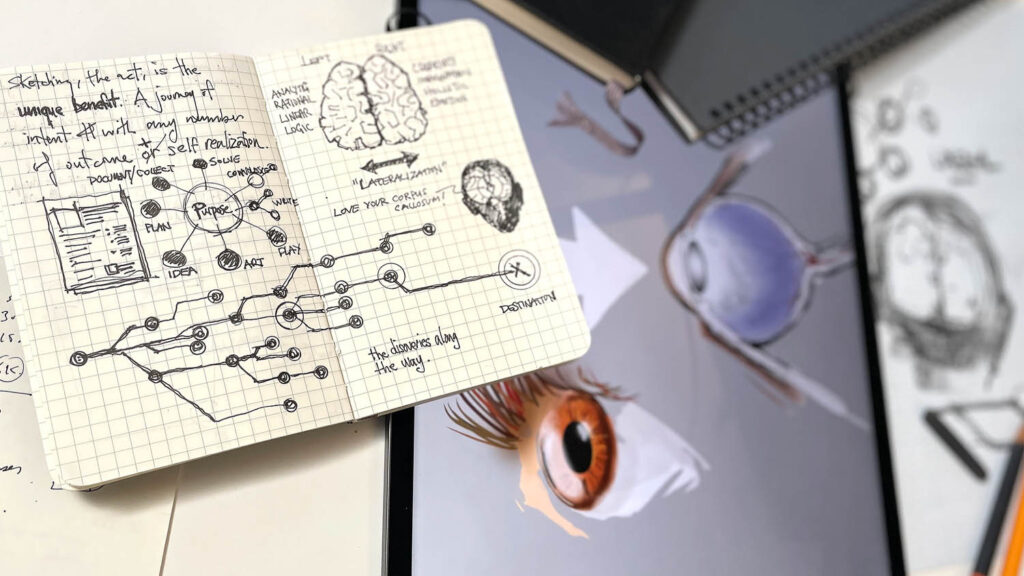At a time when we have a huge range of 3D tools at our disposal, Chris Cheung asks what role sketching should play in today’s product development processes?
We live in a time where it’s easy to jump straight into 3D CAD when designing a product. Back when I started in the industry, it still took a lot to convince people to adopt 3D earlier in the process, and to use it to replace 2D drawings.
Today, 3D is commonplace and we are midway to realising more ubiquitous applications via digital twins and reality capture, as well as discovering how virtual worlds are going to change how we make and consume. So does the dimensionally challenged 2D sketch still have a place?
As a reformed industrial designer, a maker of 2D and 3D applications and a chronic doodler myself, this is a deeply familiar topic for me. To cut to the chase, my answer to the question is ‘No’, followed by an emphatic ‘Yes!’
When looking at this from a novel technology or an investment perspective, the visionary activities in the AI space and mixed reality promise to disrupt the way we’ve been doing things over the decades.
It’s the stuff that will fuel entirely new interaction models and productivity. Looking for a similar seismic shift for the art of sketching is unrealistic, unless we take the human out of the equation – but then it wouldn’t be sketching anymore.
What makes sketching surprisingly complex are its many facets and intangible qualities.
Despite every innovation that has challenged the importance of sketching – photography, the digital imaging revolution, or the proliferation of 3D modelling and visualisation – people are still drawing. The traditional art supply market is not in decline. There is no shortage of people learning how to draw, and millions upon millions of people are also sketching on their phones and computers.
I believe sketching is ingrained in our DNA and is a fail-safe ‘reboot’ technology. Sure, we have other base technologies too – no one can deny the power of words. Language can stir the imagination and provide the level of instruction needed to tackle all kinds of projects. Yet, even the simplest of sketches can visually express concepts that a volume of written words cannot.
Sketching is everywhere
To put it simply, I believe sketching deserves legendary status. Why? For three main reasons:
The power of interpretation
Light reflects off a sketch, enters our eyes, travels along the optic nerve to the visual cortex, where parts of the brain engage to make sense of it. Lines, shapes and colours process to construct the illusion of what we think we see in the sketch. This mechanism doesn’t require completeness, accuracy or even feasibility to activate the mind in seeking connections and sparking an emotional response. This is the kind of condition most desirable for fledgling projects, leveraging interpretation to inspire lateral thinking and the formation of new ideas.
Range
Nothing comes close to the versatility of sketching. It is as effective for a business model discussion on a whiteboard as it is for envisioning an architectural structure. A sketch can illustrate very technical sequences and be used to wireframe the user interactions needed to operate it. Its capabilities even transcend use cases. Sketching can induce a state of ‘flow’, characterised by increased theta and alpha wave activity in the brain. Other studies document its therapeutic and health benefits.
Batteries not required
On any given day, I have at least two computers ablaze, three devices in tow, and about 100 browser tabs active at any given moment. But I kid you not, there is at least one piece of paper or a page from a sketchbook that saves my day, every day. If my hardware goes down or some other terrible reboot condition occurs, I may not be able to execute most of my day-to-day operations, but I know I can get shit done, traditional-style.
In summary then, sketching is not an isolated activity for the design department. It is not exclusive to those born with natural talent. Sketching is a tool to spark conversation and a cost-effective means of discovering new solutions.
It is invaluable for expressing emotional intent that drives story and design, and it is a constructive means of facilitating concurrent development practices for all those moments when a memo, spreadsheet, Jira ticket, or a dataset doesn’t quite get you to where you want to be.
Sketching may not be top of mind for every process, but people and organisations always benefit from having diverse methods for tackling problems. For this reason alone, sketching remains vital.

Chris Cheung is an advocate of creativity in business and is the founder of Mighty Dynamo, an experimental product lab and design consultancy.
More recently, he became the co-owner of Sketchbook, a popular cross-platform drawing app.






